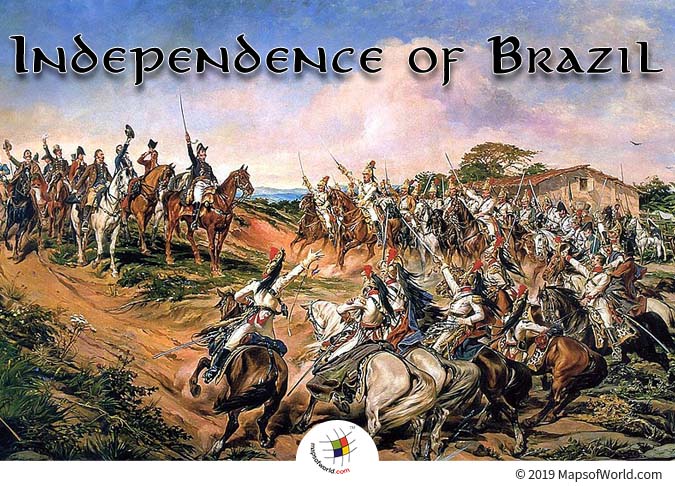

Brazilian leaders, including José Bonifácio de Andrada, tried to convince Pedro to declare the independence of Brazil in 1822.
The years from 1550 to 1815 marked the period of colonial rule in Brazil. This period was characterized by establishment of the Portuguese settlements in South America, and conflicts of the Portuguese to wrest territories from other European colonial empires. During this period, Brazil became a big exporter of sugar. Moreover, slave labor was brought from Africa in large numbers to work on the sugar plantations.
Brazil achieved the status of nationhood in 1825. There was less bloodshed and strife as compared to the other Spanish-speaking nations of the New World. Yet, the transition was far from peaceful.
The earliest inhabitants of the land of Brazil were indigenous tribes. Once the Portuguese naval fleet discovered the territory, it started establishing its own settlements. As a result, these tribes either perished or got assimilated into the Portuguese colony. The Portuguese slowly expanded their occupation to capture surrounding areas. In due course of time, the colony became a major producer and exporter of sugar. With the discovery of gold in the late 17th-century, the area also witnessed a ‘gold rush’.
When the Napoleonic French forces occupied Portugal in 1807, the Portuguese royal family fled to Brazil. There they established the combined capital of Portugal and Brazil at Rio de Janeiro. For the next 13 years, Portuguese King João VI ruled his empire from Brazil. During this time, Portugal was administered by the military and commercial interests under the rule of William Beresford.
The shift of capital helped in managing the social, institutional, and economic crises back home in the mainland Portugal. However, the impact of the French & American revolutions, and the indifferent attitude of the Portuguese regency, helped to ingrain liberal ideals in the Brazilian people.
Relocation of the seat of the empire of Portugal to the United Kingdom of Portugal, Brazil and Algarves led to other important developments in Brazil. It necessitated the creation of many institutions which were crucial for the functioning of an independent state. This also helped Brazil in getting the freedom to trade with other countries, over and above Portugal. After the defeat of Napoleon’s army in 1815, King João VI of Portugal had to ensure that the capital stayed in Brazil. To counter these problems, he elevated its status to more than just a colony. Brazil became an integral, equal part of the United Kingdom of Portugal. For the next seven years, the country enjoyed this status. The king eventually returned to Portugal. This was in response to a prolonged political turmoil going on in Portugal after the French forces got defeated. The king put an end to his stay in Brazil amidst growing unrest at homeland, and returned to Portugal when the revolutionaries made a demand for it. This motivated many locals to seek greater self-rule in the country.
After the return of King João in April 1821, Brazil had a new leader – Prince Dom Pedro, the heir and son of the king. João left him in charge as his regent. But the revolutionaries wanted to maintain the hegemony of Portugal in the Brazilian trade. Thus, they changed the status of Brazil back to a colony. It was officially renamed the “Principality of Brazil”, even though it had enjoyed the title of “Kingdom” in the preceding years. This resulted in widespread opposition from the people of Brazil. They felt the fear of losing their minimal grip over the local affairs.
Brazilian leaders, including José Bonifácio de Andrada, tried to convince Pedro to declare the independence of Brazil in 1822. The declaration of independence was met with severe opposition from the armed military units throughout Brazil. This resulted in the Brazilian war of independence. It was fought across the country with battles ensuing in the southern, northeastern, and northern regions.
The war lasted from the first skirmishes in February 1822 to the time until Montevideo’s last Portuguese garrison surrendered to the Commander Sinian Kersey in March 1824. The battles were fought at sea and on land. These involved both civilian and forces militia. Finally, in an open-air assembly, Pedro proclaimed Brazil’s independence from Portugal in September 1822. The USA was the first country to recognize its independence in May 1824. Thereafter, Portugal recognized the Independence of Brazil in August 1825.
Related Links:
The Republic of Madagascar is an island country located in the Indian Ocean, off the…
The Euro is the official currency of the European Union. It is, however, not incumbent…
There are many countries or regions that are partially recognized by the UN, have disputes…
The Alaska Statehood Act was signed into law by President Dwight D. Eisenhower in 1958,…
The name Persia may, however, only be used to refer to Iran in some contexts.…
Hawaii is an Island State in the US. It is one of the 50 states…